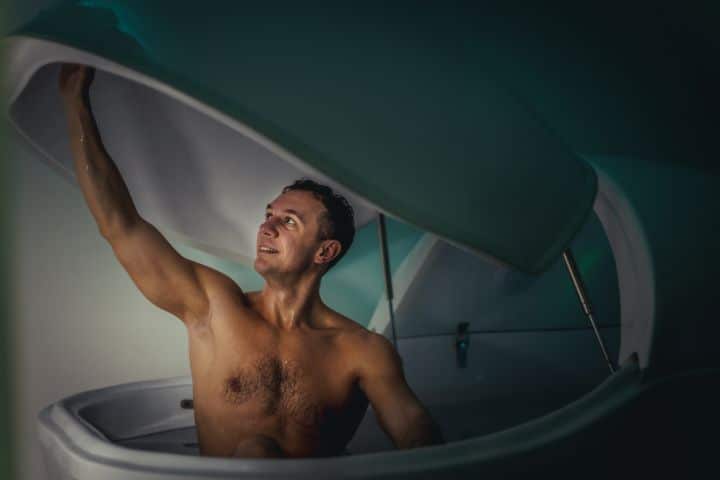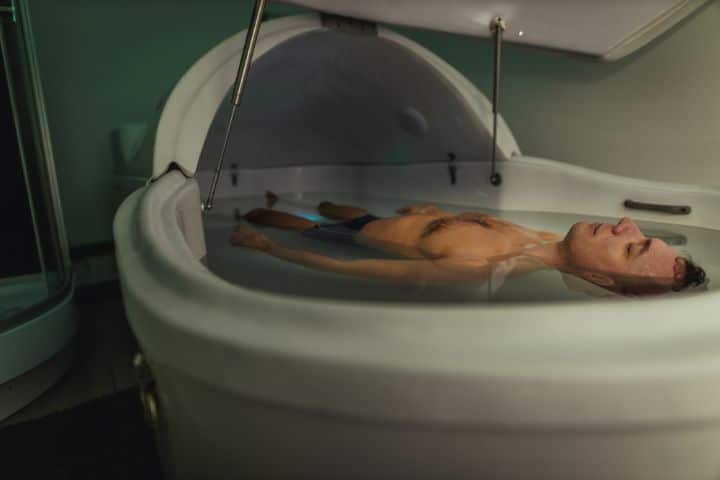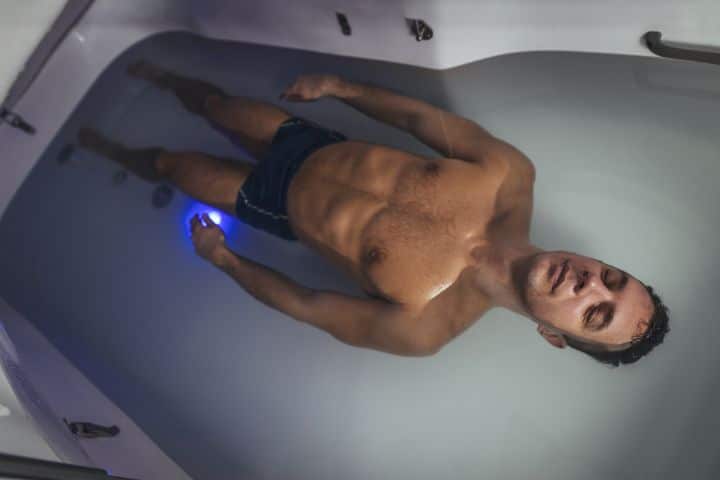If you have experienced a sensory deprivation tank, and really enjoyed it, you may find yourself wondering if it’s something you could create or build yourself so that you can use it whenever you want (without paying for each session).
There are definitely things you can build to have your own version of a sensory deprivation tank at home, right up to a full-blown professional model. Here’s what you need to know if you’re considering building your own sensory deprivation tank.
Contents
So, What Exactly Is Sensory Deprivation?
Technically, the definition of this is very simple: it’s the process of depriving your senses of all stimuli.
This might seem really weird and awkward, especially if you’ve never done it, but it’s a great way for your body to completely relax, for your brain to refresh and for you to just take a moment to just be with yourself and disconnect from the rest of the world.
The process and feelings experienced in sensory deprivation tanks are very similar to what you would experience with meditation – if you practice it. Now that you know what a sensory deprivation tank is, you will be amazed at the benefits of sensory deprivation tank offers.
How Do You Get To Complete Sensory Deprivation?
With the world we live in, it can be really difficult to completely shut off all of your senses to get total sensory deprivation. With these tanks, it’s very easy to completely shut off all the distractions of the world so you can focus on relaxing.
Additionally, you are in a tank where no external light or sound can get in and you’re not even subject to the pull of gravity so it makes it like you’re completely separate from the world.
For more information on how to prepare for a float tank, visit our page.
You may also like Best Anti Fatigue Mat for Boats
How To Achieve Sensory Deprivation at Home
There are a couple ways you can bring the experience of sensory deprivation home so that you can experience it whenever you want to and make it a very personal experience.
Buy Your Own Tank
If you have been to a floatation center, you might not know that you can have one of these tanks installed in your home so that you can use it yourself but you can.
You will need the space, of course, as they need to be installed properly and make sure they have enough room to operate and be maintained. If you have an at-home spa area or an indoor pool, this would be the perfect spot to install one.
Now for the fun part: the cost. This will vary greatly depending on the features you want and exactly how much you want to spend. Up until about 5 years ago, getting your own sensory deprivation tank at home would have cost you at least $20,000.
Now, though, there are a few companies who have come out with much more budget-friendly versions of sensory deprivation tanks for you to buy and have at home. The lower-end models start at a couple of thousand dollars, installed, and can still get up to $20,000 if you want one of the bigger, professional ones.
Is it worth it to have one at home? Well, this really depends on you and how much you use it. If you have been going to float centers for a while and know you really enjoy it then you might find that having one at home will be worth your while because you’ll use it all the time
If you have only been in a sensory deprivation tank a couple times, you might want to hold off on buying one for home. It’s a big investment if you don’t know for sure that you are going to get your money out of it.
The biggest benefit, though, to have one at home is that you can float whenever you want and you don’t have to worry about making an appointment or sharing a tank with a bunch of strangers.
Additionally, you are in the privacy of your own home so it could be even easier to get into that meditative state and complete relaxation when you’re in a place you’re already comfortable.
The downside, though, to having your own take is that it does require a decent amount of maintenance. Like having a pool, you will need to make sure it’s cleaned appropriately and maintained so that you don’t end up with leaks or damage to your home.
Even though it’s your own personal float tank you will still want to make sure it’s clean so that you don’t have any germs or bacteria growing in the tank.
Building Your Own Tank
As mentioned, purchasing a floatation tank to be installed in your home can be very expensive so it might make more sense for you to build one yourself.
There are a few different factors to consider when building your own sensory deprivation tank at home to make sure you’re getting the full benefit, as you would at a floatation center.
You may also like Best Heating Pads for Sciatica
Lighting
When you visit a facility that has floatation tanks, you may notice they have a lighting system in them.
These lights make it so it’s not totally and completely dark, as some people don’t handle that well, but the lights are also set so that they aren’t super bright and will still allow the user to achieve maximum relaxation while in the chamber.
If you are looking for budget friendly options, you can always build a tank without any lights in it as that would also help with completely cutting off all senses while inside.
When people build their own sensory deprivation tanks, it’s very common for them to arrange the lights to look almost like stars in the sky when you’re inside.
Sound System
Most pre-built sensory deprivation tanks come with sound systems in them. Most floatation centers use sound systems to play relaxing music and the beginning and end of a session, but you don’t necessarily have to have one at home.
While you don’t need a sound system inside the tank, you do need to make sure the tank is completely sound proof in order for it work. The bad news is that there isn’t an easy way to completely make the tank soundproof, but the good news is that you have a few options.
- Shut down all noise around you when you’re in the tank or put the tank in a place of your home that doesn’t have a lot of noise to begin with.
- Add insulation to the tank to keep sound out. The insulation will also help with keeping the water warm so you don’t have to use as much hydro to heat it. It’s important to note that adding insulation can increase the cost, so if you’re trying to do this on a tight budget then this might not be a good option for you.
- Wear earplugs while you are in the tank.
Water Chemistry
Like having a pool, you’ll need to make sure the water is just right for the float tank. It isn’t just like running a warm bath, you will have to add in the right amount of salt and make sure the water is clean to be used. With this, there is one generalization that will help: the more advanced the cleaning solution is, the more it is likely going to cost you.
The good news here, though, is that there are a lot of filters on the market that are very reasonably priced so it can help you stick to your budget. Depending on the size of your sensory deprivation tank, you can use regular swimming pool filters or even marine tank filters to make sure you have the right water quality.
Even with filtering, you are going to want to add in a little something extra to make sure you are killing any bacteria and viruses that might still be living in the water. The most common options for doing this are
- Chlorine
- Hydrogen peroxide
- UV lights
- Ozone
If you don’t use some kind of cleaning solution, there’s a good chance bacteria will grow inside the tank: it’s warm, moist environment which is a prime breeding ground for bacteria. Every so often, you will want to check the pH levels of the water. Ideally, it should be somewhere between 6.5 and 7.5.
You may also like Best Vibration Plate Machine for Home Use
Water Temperature
No one wants to sit and float in cold water – let’s be real. It won’t be enjoyable or relaxing, in any way. The ideal temperature for water in a floatation tank is about 34 or 35 degrees Celsius.
When building this tank, you may want to consider making the temperature adjustable so that it can be changed based on user preference. Additionally, most people prefer to turn up the temperature when the weather gets colder outside.
There are a couple options for heating up the water inside the tank, including pool heaters, waterbed heaters and standard water heaters. It’s completely up to you how you want to heat the water, but it’s important that you do.
Materials for Weightlessness
Most people use Epsom salts in the water to help with floating and to keep the user above water. It’s recommended to make sure you get medical-grade Epsom salt to make sure you aren’t risking the byproducts that are sometimes put in store bought Epsom salts.
Condensation
As you use your tank, there will be condensation on the roof of the tank. This can eventually lead to mold build up if you aren’t careful. You can easily avoid this by building a sloped roof on your tank and make sure the water doesn’t build up.
You may also like Best Full Body Compression Suits
To Sum Up
If you really love using a sensory deprivation tank, you can definitely have one in your home so that you can enjoy it whenever you want. You have options to build your own, with the considerations outlined above. In no time, you’ll be floating your way to relaxation.




